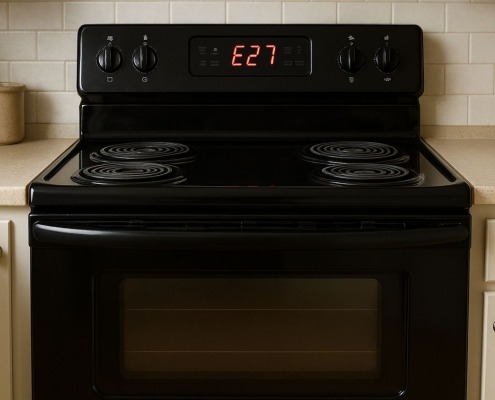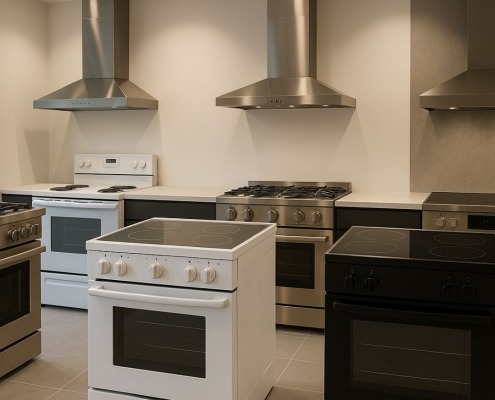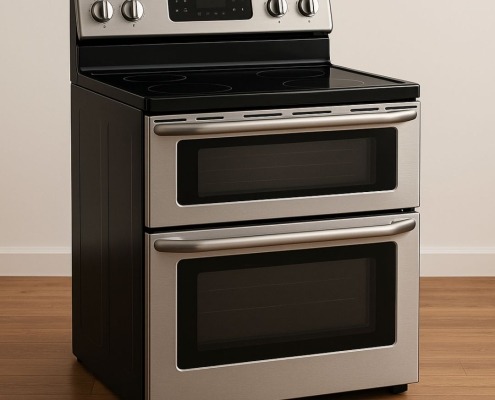5 ways to unlock an oven door that won’t open
Samantha Bullington / Wednesday December 20, 2023
Is your oven door stubbornly refusing to open, leaving you in an inconvenient bind? Don’t worry, you’re not alone, and we’ve got the perfect solution to get your cooking routine back on track. Check out our step-by-step guide below, complete with a handy how-to video, to easily unlock your oven door and reclaim your kitchen.
If you’re facing the frustrating predicament of a locked oven door that refuses to open, you’re not alone! Whether it’s due to an accidental self-clean cycle initiation or some other issue, you should be able to use the following guidelines to unlock the oven door.
Watch: Door will not open after self-clean cycle
The information in this article may not apply to your specific appliance model. We recommend consulting your manufacturer’s documentation or contact us with any questions.
How to unlock the oven door
If you accidentally started a self-clean cycle
- Try initiating the self-clean cycle again. Odd as it may sound, starting the cycle once more may allow it to run its course, ultimately unlocking the oven door as the final step.
- Wait for the oven to cool off. Oven locking mechanisms are heat-sensitive, meaning they’ll unlock once the oven cools down. So you can simply wait for your oven to cool. It might take some time, but your door should eventually unlock.
If you left a meal inside
- Shut off the power to your oven. You can either unplug it or switch off the circuit breaker. Leave the power off for at least 10 minutes to give your oven time to reset.
- Don’t force the door open since you could damage the oven or hurt yourself in the process.
- Plug the oven back in or switch the circuit breaker back on. You’ll likely find that the door can be opened after the reset.
Read more: Oven Tips for Cooking a Holiday Turkey, Ham & More
If the lock-out feature is engaged
Some ovens include a lock-out feature designed to engage during self-cleaning cycles or when the oven operates at high temperatures. To deactivate this feature:
- Find the lock-out pad button or switch, which often displays a lock icon. Refer to your oven’s owner’s manual if you can’t find it.
- Deactivate the lock-out feature by pressing and holding the Timer/On-Off button for about 4-5 seconds. The lock-out pad indicator light should turn off and you should hear a beep indicating that the feature is deactivated. Once the Padlock icon disappears from the screen, you should regain control of your oven.
If the oven is locked open
- Press and hold the door switch button. Keep holding it until the next steps.
- Initiate the self-clean cycle by pressing and holding the self-clean button for a few seconds. You should see the self-clean indicator light on the oven display, indicating that the cycle has started.
- After about 20 seconds, cancel the self-cleaning mode. Your oven door should unlock as it cools down. Once it’s unlocked, you can close the door.
If you need to manually disengage the lock
While this scenario is less common, it’s important to know what to do.
- Check your oven’s user manual to find information about the access point for manual disengagement. Different oven models may have various mechanisms, so following the manufacturer’s guidance for your oven model is important.
- Find the lock mechanism from inside the oven and disengage it. This process might involve lifting up the range top or accessing the lock from the back, depending on your oven’s design.
Read more: How to prevent appliance fire hazards
Why do oven doors lock?
Oven-locking mechanisms help with:
- Safety: When the oven senses an unsafe temperature range, it can engage the door lock to prevent unsafe conditions. The door also locks to prevent accidents and injuries when the appliance reaches scorching temperatures during a self-clean cycle.
- Temperature control: Locking mechanisms help maintain a stable and controlled temperature within the oven during high-temperature cooking.
How to prevent oven door locking issues
Knowing how to prevent unwanted locked oven doors is just as important as knowing how to address them when they happen. Here are some tips to keep in mind:
- Always select the appropriate oven setting for your cooking needs. Using the wrong setting can lead to unexpected door locking.
- Avoid slamming the oven door shut. Forceful closures can damage the door mechanism and potentially cause locking issues.
- Regularly clean the oven interior to prevent debris from accumulating and interfering with the door mechanism.
- Periodically inspect the hinges and handles of your oven for signs of wear or damage. If you notice any issues, replace them as needed to keep your door functioning correctly.
- If you have young children at home, consider installing child safety locks on your oven to prevent accidents.
Read more: How to fix common appliance issues during Thanksgiving
More information
By following the manufacturer’s instructions, prioritizing safety and exercising some patience when handling locked oven doors, you can set yourself up for a hassle-free cooking experience in your kitchen.
Thanks for reading! If you have any other appliance repair needs or projects, you can find more resources including our DIY blog at AppliancePartsPros.com. There, you can enter your model number to order the exact parts you need. Most orders arrive in two business days.
You can also reach our award-winning customer service team at 1-877-477-7278, chat with a pro on our website and watch thousands of free video tutorials on our YouTube channel.
Hey there, I’m Samantha and I’m super excited to be a part of the Appliance Parts Pros team! With 9 years of experience, I’ve had the awesome opportunity to assist countless customers in troubleshooting their home appliances and finding DIY repair solutions.





